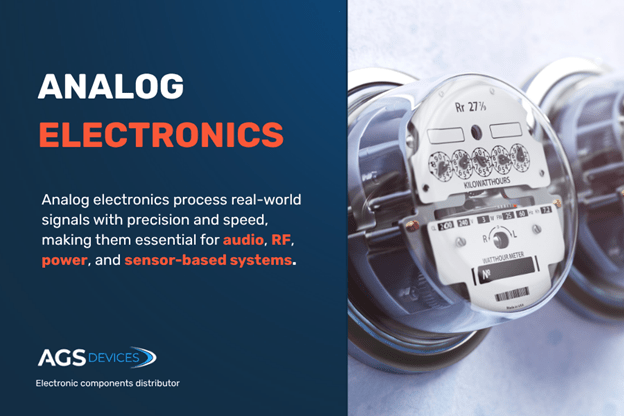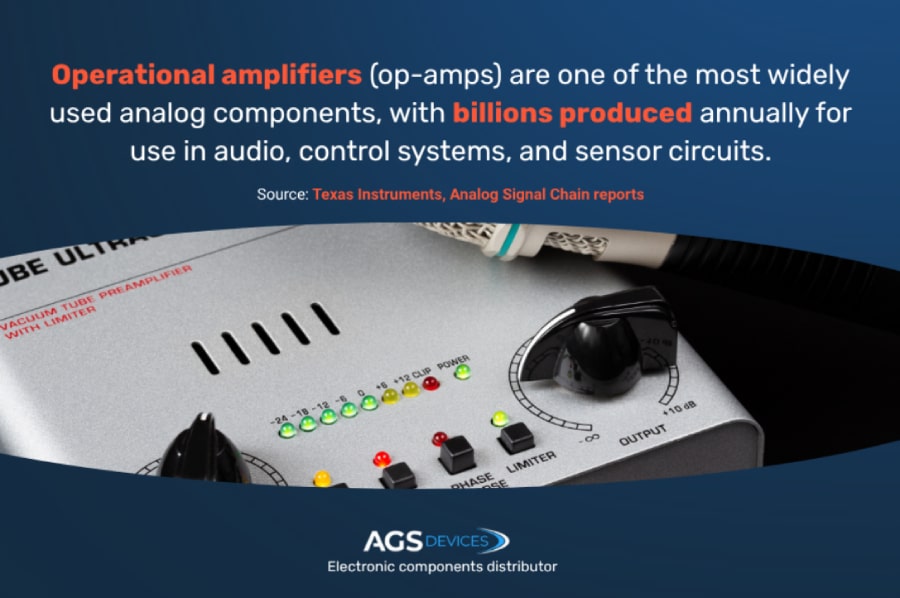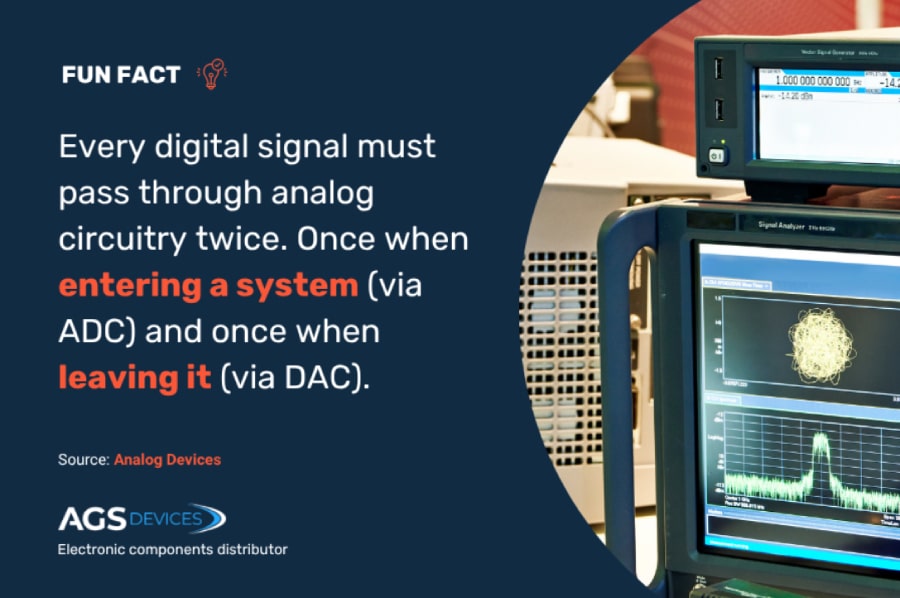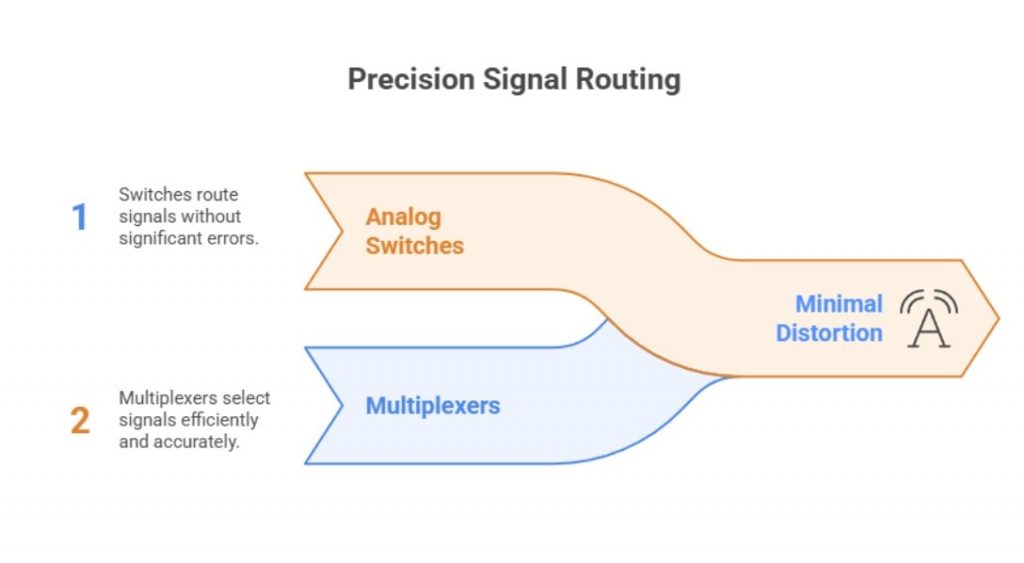
Analog Electronics: Key Takeaways
- Analog electronics are essential in systems that require real-time signal control, continuous voltage regulation, and high-fidelity response, especially in audio, RF, and power applications
- Modern devices in automotive, industrial, and medical sectors still rely on analog components like op-amps, filters, and voltage regulators to process signals that digital circuits can’t handle alone
- Analog and digital circuits increasingly work together in hybrid systems, where analog front ends capture and condition signals before digital processing
- Key advantages of analog circuits include low latency, precise signal shaping, and direct interfacing with sensors and physical environments
- AGS Devices helps engineers source high-quality analog components with full traceability, ensuring performance and compliance across demanding applications
Over 90% of real-world signals, from sound and temperature to voltage and pressure are analog by nature, not digital.
That means no matter how advanced your system gets, interfacing with the physical world still depends on analog electronics.
From high-fidelity audio and RF tuning to power regulation and sensor feedback, analog circuits remain the backbone of real-time signal control and precision performance.
In this guide, we’ll break down:
- What analog electronics are and why they still matter
- Key applications in audio, radio, and power systems
- The differences between analog and digital circuits
- Core components that drive analog designs
- Real-world examples across industrial, automotive, and medical use cases
Why Analog Electronics Matter Today
Despite the rise of digital technology, analog electronics remain foundational to modern system design.
Analog electronics are essential for:
- Interfacing with the real world: Sensors and transducers output analog signals that must be conditioned before digital conversion
- Real-time responsiveness: Analog systems operate without sampling delays, making them ideal for power regulation, audio fidelity, and high-frequency RF applications
- Signal accuracy and fidelity: Audio, radio, and power systems often require smooth, uninterrupted signal paths where precision matters more than binary logic
In fact, most digital systems still rely on analog front-ends for input, filtering, and output, making analog circuits indispensable in mixed-signal designs.

How Analog Electronics Drive Audio, Radio, and Power Systems
Analog electronics aren’t just legacy technology; they’re mission-critical in applications where continuous signals and real-time response are non-negotiable.
Here’s how analog systems power key domains:
Audio Systems: Preserving Signal Integrity and Dynamic Range
From consumer earbuds to professional amplifiers, analog electronics are essential in capturing and delivering clean sound.
Analog circuits handle:
- Pre-amplification of microphone signals
- Tone control and equalization (bass and treble filters)
- Volume and gain control with minimal digital noise
- Analog-to-digital (ADC) interfacing for recording systems
Used in:
- Studio mixers
- Headphone amplifiers
- Guitar pedals
- Smart speakers and voice assistants
Engineering insight: High-fidelity audio relies on analog signal chains to maintain smooth transitions and prevent “stair-stepping” caused by digital conversion
Radio Systems: Tuning and Modulating Real-Time RF Signals
Analog circuits are fundamental in generating, filtering, and tuning radio frequency signals.
Their low latency and continuous response make them ideal for communication systems.
Key analog roles in radio include:
- Oscillators that generate carrier frequencies
- Mixers for modulation and demodulation
- Analog filters to eliminate unwanted frequencies
- Automatic gain control (AGC) to balance signal strength
Used in:
- AM/FM radios
- Satellite communications
- Wireless transceivers
- Remote keyless entry systems
Did you know? Most SDR (software-defined radio) systems still use analog front ends to capture and clean RF signals before digital processing.
Power Systems: Real-Time Voltage Control and Efficiency
Analog circuits provide feedback control, protection, and energy efficiency that are essential in applications where digital latency could cause instability.
Analog functions in power systems:
- Voltage regulation (e.g., LDOs, switching regulators)
- Overcurrent and thermal protection
- Feedback control loops for converters
- Precision reference voltages in control ICs
Used in:
- Industrial motor drives
- EV battery chargers
- Solar inverters
- Consumer AC/DC adapters
Tip for sourcing teams: When designing or sourcing power regulation systems, always evaluate analog performance specs like transient response, load regulation, and quiescent current — especially in battery-sensitive devices.

Key Applications of Analog Electronics in Modern Devices
Analog electronics are critical in systems where real-time signal integrity, voltage control, and environmental sensing are required.
Here are the most common applications:
- Audio systems: Analog circuits drive amplification, equalization, and filtering in everything from smartphones to professional soundboards.
- Power regulation: Analog feedback loops control voltage and current in converters, power supplies, and battery management systems.
- Radio frequency (RF) systems: Tuners, oscillators, and filters enable precise signal modulation in wireless and satellite communication.
- Sensing and instrumentation: Analog interfaces process continuous input from sensors in medical devices, industrial monitors, and environmental controls.
- Automotive systems: Analog-to-digital conversions, power regulation, and sensor conditioning support engine control units (ECUs), ADAS, and in-vehicle infotainment.
- Aerospace and defense: Analog front ends handle high-reliability signal processing in radar, guidance systems, and avionics.
Even in the most advanced digital systems, analog circuits play an invisible but essential role — enabling digital logic to interact with the real world.
Essential Components Used in Analog Electronics
Analog systems depend on a core set of components that process real-world signals with precision and control.
Below are the most essential building blocks of analog electronics.
1. Operational Amplifiers (Op-Amps)
Used for signal amplification, voltage comparison, filtering, and integration
- Found in: Audio preamps, analog filters, sensor conditioning, control loops
- Design tip: Look for rail-to-rail op-amps for low-voltage systems with limited headroom
2. Resistors and Capacitors
Fundamental to analog timing, signal shaping, filtering, and voltage division
- Used in: RC filters, gain setting, impedance matching
- Sourcing note: Tight-tolerance resistors and low-ESR capacitors are key for precision analog designs
3. Analog Switches and Multiplexers
Route or select between multiple analog signals with minimal distortion.
- Used in: Data acquisition systems, sensor hubs, audio signal routing
- Use case: Enables single-ADC designs to read multiple analog inputs efficiently

4. Voltage Regulators (Linear and Switching)
These maintain stable voltage levels across analog loads.
- Found in: Power supplies, RF front ends, analog control systems
- Engineering insight: Analog systems are sensitive to noise; low-dropout (LDO) regulators are preferred for noise-critical analog rails
5. Comparators
Detect voltage thresholds and trigger logic events in analog domains.
- Used in: Zero-cross detectors, overcurrent protection, PWM control circuits
- Advantage: Ultra-fast response time compared to digital equivalents in real-time systems
6. Analog Filters (Active and Passive)
These filters shape or block frequencies to preserve signal quality.
- Used in: Audio equalizers, RF tuners, sensor signal conditioning
- Component tip: Active filters using op-amps offer more precise control than passive-only designs
4 Real-World Examples of Analog Electronics in Use
Analog circuits quietly power countless systems we depend on daily, especially in domains where precision, real-time control, and continuous signal handling are essential.
Below are real-world examples that show where analog still leads.
1. Audio Systems
Analog preamps, filters, and amplifiers shape and preserve sound quality in everything from headphones to studio equipment. These components manage dynamic range, distortion control, and clean signal transitions.
Used in:
- Professional mixing consoles
- Smart speakers and earbuds
- Guitar pedals and amplifiers
- Car infotainment systems
2. Power Regulation in EVs and Grid Systems
Analog feedback circuits in power management ICs ensure voltage stability, thermal protection, and energy efficiency in real time, functions digital systems alone can’t guarantee fast enough.
Used in:
- EV battery chargers
- Solar inverters and smart meters
- DC-DC converters in power tool systems
3. Telecom and RF Communications
High-frequency signal processing still relies heavily on analog components like mixers, oscillators, and band-pass filters for low-latency, high-fidelity modulation and tuning.
Used in:
- Satellite transceivers
- Wireless base stations
- Radar and RF test equipment
4. Medical and Industrial Instrumentation
Analog front ends condition low-voltage signals from sensors before digital conversion. These ensure accurate measurements in safety-critical environments.
Used in:
- ECG and EEG machines
- Industrial automation sensors
AGS Devices Delivers the Right Electronic Components
Analog electronics remain essential for real-time performance, signal accuracy, and continuous control in today’s most demanding systems.
From audio to power to RF, engineers count on analog circuits where digital alone won’t cut it, and that makes component quality, sourcing reliability, and traceability non-negotiable.
At AGS Devices, we provide electronic components such as:
- Power Supply Distributors
- Semiconductors for Sale
- Optoelectronics
- Circuit Protection
- Interconnects
- Passive Components Electronics
- Electronic Testing Equipment
- Electromechanical Devices
We also support your analog design needs with:
- High-performance analog components including op-amps, filters, and power ICs
- Traceable sourcing and quality assurance for mission-critical applications
- Lifecycle and inventory management to support long-term reliability
- Expert support for BOM optimization and part selection
Whether you’re designing a power supply, an RF frontend, or an audio signal path, AGS Devices is your partner in sourcing analog electronics you can trust.
Analog Electronics: FAQs
What is an analog circuit?
An analog circuit processes continuous voltage or current signals, unlike digital circuits, which operate in discrete binary states. Analog circuits are used for real-time applications like audio amplification, voltage regulation, and signal filtering.
Where are analog electronics still used today?
Analog electronics are critical in audio systems, power converters, radio frequency (RF) communications, sensor interfaces, and control loops, especially in automotive, medical, industrial, and aerospace systems.
What’s the difference between analog and digital circuits?
Analog circuits handle continuous, variable signals and are ideal for real-world interfacing. Digital circuits process discrete values (0s and 1s) and are better for computation and logic. Most modern systems use both analog front ends with digital processing.
Why use analog components in a digital system?
Digital systems often need analog interfaces to interact with real-world inputs like sound, temperature, voltage, or motion. Analog components handle signal conditioning, filtering, and real-time feedback before conversion.
Can analog and digital circuits work together?
Yes. Many systems are mixed-signal, combining analog and digital components. For example, a sensor’s analog output is amplified and filtered before being digitized by an ADC for processing by a microcontroller.


